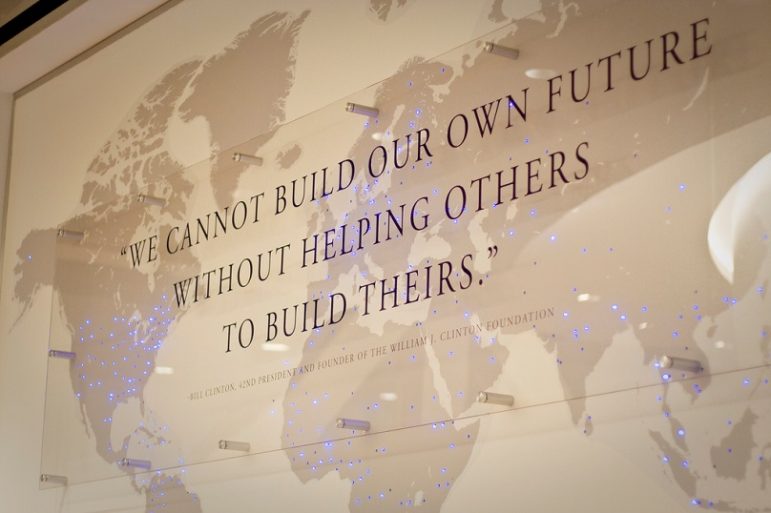
May 12, 2016; Wall Street Journal
On Friday, May 13th, the Wall Street Journal published an article about the Bill, Hillary, and Chelsea Clinton Foundation’s Clinton Global Initiative, suggesting that a “family friend” had benefitted by a grant that was made in 2010 through the foundation to a for-profit energy refitting company in which the friend had partial ownership. The story is made a bit spicier elsewhere by speculation that the friend is more than a friend to the former president but, honestly, we’d rather set that almost immaterial piece of the story aside for now and deal with what is alleged to have happened.
As most readers already know, the Clinton Global Initiative acts as a matchmaker for monetary commitments from corporations, individuals, or nonprofit organizations to social endeavors of many different kinds. And in this case, long story short, it appears that Bill Clinton personally inserted this project into a CGI conference agenda relatively late in the process as support for Kim Samuels, a donor who had already committed $2 million to the project (later reduced to $500,000 after she had done due diligence). The intervention on the agenda resulted only in Samuels announcing her investment, which was made through the foundation, from the stage of the annual conference.
In this age of toying with sector agnosticism, readers will find nothing especially unusual about a foundation providing or facilitating a grant or other investment to a mission-aligned for-profit company. The company in question here is Energy Pioneer Solutions, a startup meant to provide insulation for rural housing as an energy-saving enterprise—accordingly, it fits relatively neatly into a portion of CGI’s foci. This appears to have been a donor-directed investment through the foundation; there’s no indication Clinton did anything other than actively provide a forum for announcing the grant and a vehicle through which to give it.
The fact that the people who held ownership in the company were active in the Democratic Party is not all that unusual either. It has never been a secret that Clinton expected CGI to act through networks new and old, and he has never exempted his own circle of friends and acquaintances from that, though the wise thing to do would have been to step back from exerting any influence over the system where an especially close friend was concerned.
The Foundation’s chief communications officer, Craig Minassian, said that although the former president is not involved in the company, he did make many friends while in public service who are “involved in CGI commitments because they share his belief in positive impact in the world.”
“Many for-profit companies are addressing climate change and helping reduce dependency on fossil fuels by building solar panels, operating wind farms, and retrofitting buildings to be more energy efficient. Impact and mission-driven investing are major trends in philanthropy,” Minassian said.
As John Wonderlich, executive director of the Sunlight Foundation, says, there is plenty of grey area on some of those sector agnostic initiatives. “My quick take is, like a lot of things around the Clintons, things quickly get polarized when really it’s a pretty complicated issue. The Clinton Foundation by its nature blurs charity, business, politics. […] It’s an initiative bigger than our nonprofit laws deal with.”
Sign up for our free newsletters
Subscribe to NPQ's newsletters to have our top stories delivered directly to your inbox.
By signing up, you agree to our privacy policy and terms of use, and to receive messages from NPQ and our partners.
In fact, on its surface, this particular situation seems to have been teed up more because it involved speculations about Bill’s sex life than from a sense there was true malfeasance, an implication that has yet to be firmly upheld. Media Matters tracks the story back to a National Enquirer report complete with the use of the terms “blond bombshell,” “busty,” and even the retro “divorcee.” Perhaps in the end something nefarious will be proven, but for now, there is just no definitive “there” there on this on—except that it plays on a basic distrust of the Clintons’ ability to be reliably on the up-and-up.
Memories of the former president’s tenuous relationship with the truth would suggest that he should have paid special attention to any potential for problems of perception. Here we have the result—a story involving a busty blond bombshell of a divorcee combined with the general lack of public familiarity with anything but the most basic mechanics of philanthropy, even as it wanders into new forms.
The bigger problem here may lie in what John Wonderlich described in the act of blending of politics, charity, and business. That is, after all, the troublesome nexus from which the questions about Hillary’s relationship with ExxonMobil emerged.
Rick Cohen wrote often about the Clinton foundation and faulted it for the way it neglected to be prepared to answer inquiries about a number of such close and blurry relationships. Almost exactly a year ago, he wrote, in “Full, Accurate & Anticipatory Disclosure Would Help Put Clinton Foundation Media Stories to Bed”:
The Clinton Foundation and the Clinton apparatus seems to have stumbled over some sloppiness in failing to anticipate the range of inquiries it might have logically expected and prepared for with a former First Lady, senator, and Secretary of State running for president.
[…]
When a politically connected foundation has to revise and explain as much as the Clinton Foundation does, it suggests the foundation wasn’t really prepared for the kind and persistence of inquiries it would face. A better approach, which is beyond the letter of the current law, would be for foundations related to, established by, or controlled by politicians or their staff members to straight out disclose their donations above a certain level. Imagine how much simpler the life of the Clinton Foundation would have been had it simply done that from the beginning. The story, such as it has metamorphosed, would have been much less than it has become.
—Ruth McCambridge











